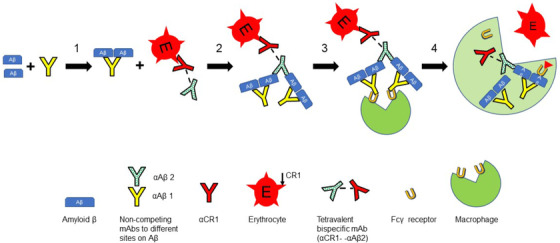FIGURE 1.

Schematic diagram of the alternative targeting strategy. Step 1, a non‐competing monoclonal antibody (mAb) binds to amyloid beta (Aβ) in the bloodstream. The initial concentration of Aβ is ∼ 0.07 nM [8, 20]. Step 2, the erythrocyte‐bound bispecific construct mediates binding of the Aβ‐mAb complexes to the erythrocyte. Under these conditions as many as four Aβ can be bound per complement receptor 1 (CR1). Step 3, the erythrocyte‐bound immune complex traffics to the liver and spleen where it will be engaged by Fcγ receptors on the macrophage. Step 4, the immune complex, along with CR1, is taken up and internalized by the macrophage but the erythrocyte returns to the circulation. Based on an average of 500 CR1 per erythrocyte, and 5 × 1012 erythrocytes per liter of blood, the concentration of erythrocyte‐associated CR1 is ≈ 4 nM. Therefore, the system has the potential to clear as much as 16 nM Aβ
